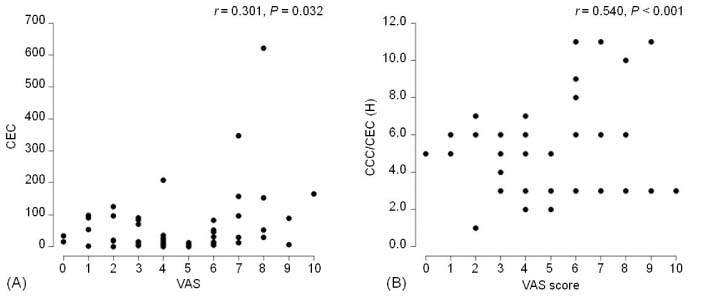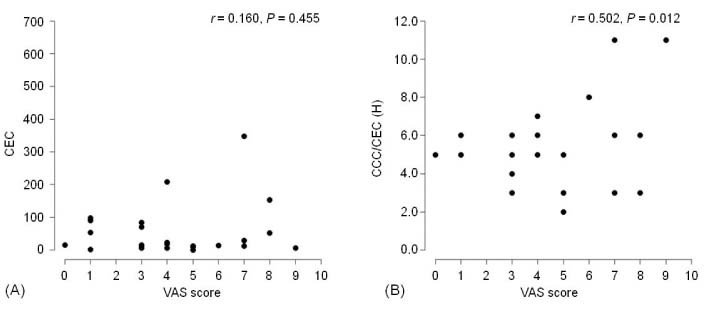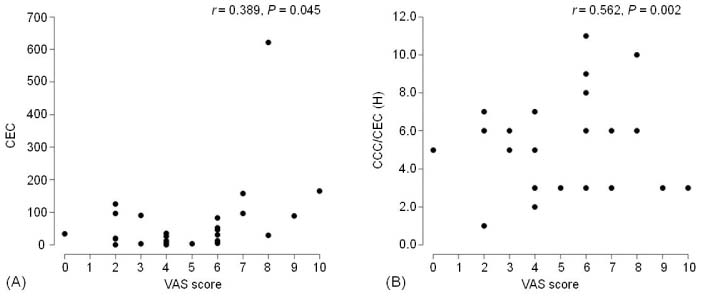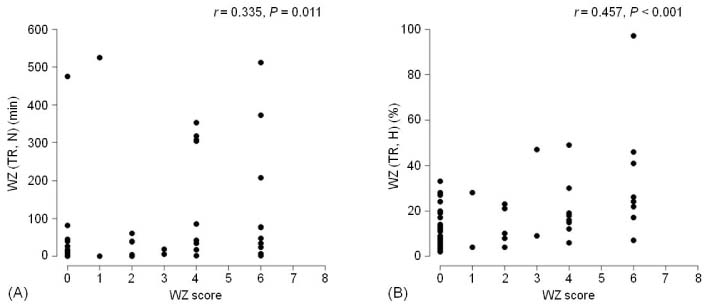Pediatr Allergy Respir Dis.
2012 Dec;22(4):344-353.
Validity of Cough-Holter Monitoring for the Objective Assessment of Cough and Wheezing in Children with Respiratory Symptoms
- Affiliations
-
- 1Department of Pediatrics, Korea University College of Medicine, Seoul, Korea. yoolina@korea.ac.kr
- 2Department of Pediatrics, Hanil General Hospital, Seoul, Korea.
- 3Environmental Health Center for Childhood Asthma, Korea University Anam Hospital, Seoul, Korea.
- 4Department of Pediatrics, Mokpo Hansarang Hospital, Mokpo, Korea.
Abstract
- PURPOSE
Cough and wheezing are the most common respiratory symptoms in children. Recently, the cough-holter monitoring has been used to estimate the frequency and intensity of cough and wheezing, objectively. In this study, we aimed to evaluate the validity of cough-holter monitoring for the objective assessment of cough and wheezing in the hospitalized children with respiratory symptoms.
METHODS
Cough-holter monitoring was performed in 59 children who suffered from cough and/or wheezing. We obtained the information on the frequency and intensity of cough and wheezing from the parents, a pediatrician, and cough-holter monitoring. Visual Analogue Scale (VAS) scores were taken by parents, and the pediatrician estimated the wheezing score by using a stethoscope. We assessed a relationship between the VAS scores, wheezing score, and cough-holter monitoring data.
RESULTS
The frequencies and intensities of cough correlated positively with the VAS scores (r=0.301, P=0.032; and r=0.540, P=0.001, respectively) and the frequencies and intensities of wheezing also correlated positively with the Wheezing scores. (r=0.335, P=0.011; and r=0.457, P=0.001, respectively) The wheezing intensity did not correlate with the Wheezing score in wheezing children. (r=0.321, P=0.089)
CONCLUSION
Cough-holter monitoring correlated positively with the VAS scores and the wheezing scores. Cough-holter monitoring appears to be a useful objective assessment tool for the children who have suffered from cough and/or wheezing.
Keyword
Figure
Reference
-
1. Ilangovan P, Pedersen S, Godfrey S, Nikander K, Noviski N, Warner JO. Treatment of severe steroid dependent preschool asthma with nebulised budesonide suspension. Arch Dis Child. 1993. 68:356–359.
Article2. Lowell DI, Lister G, Von Koss H, McCarthy P. Wheezing in infants: the response to epinephrine. Pediatrics. 1987. 79:939–945.
Article3. Schultz A, Brand PL. Episodic viral wheeze and multiple trigger wheeze in preschool children: a useful distinction for clinicians? Paediatr Respir Rev. 2011. 12:160–164.
Article4. Hsu JY, Stone RA, Logan-Sinclair RB, Worsdell M, Busst CM, Chung KF. Coughing frequency in patients with persistent cough: assessment using a 24 hour ambulatory recorder. Eur Respir J. 1994. 7:1246–1253.
Article5. Archer LN, Simpson H. Night cough counts and diary card scores in asthma. Arch Dis Child. 1985. 60:473–474.
Article6. Taylor JA, Novack AH, Almquist JR, Rogers JE. Efficacy of cough suppressants in children. J Pediatr. 1993. 122(5 Pt 1):799–802.
Article7. Chang AB, Newman RG, Carlin JB, Phelan PD, Robertson CF. Subjective scoring of cough in children: parent-completed vs child-completed diary cards vs an objective method. Eur Respir J. 1998. 11:462–466.
Article8. Chang AB, Phelan PD, Robertson CF, Roberts RG, Sawyer SM. Relation between measurements of cough severity. Arch Dis Child. 2003. 88:57–60.
Article9. Faruqi S, Thompson R, Wright C, Sheedy W, Morice AH. Quantifying chronic cough: objective versus subjective measurements. Respirology. 2011. 16:314–320.
Article10. Decalmer SC, Webster D, Kelsall AA, McGuinness K, Woodcock AA, Smith JA. Chronic cough: how do cough reflex sensitivity and subjective assessments correlate with objective cough counts during ambulatory monitoring? Thorax. 2007. 62:329–334.
Article11. Bentur L, Beck R, Shinawi M, Naveh T, Gavriely N. Wheeze monitoring in children for assessment of nocturnal asthma and response to therapy. Eur Respir J. 2003. 21:621–626.
Article12. Levy ML, Godfrey S, Irving CS, Sheikh A, Hanekom W, Bush A, et al. Wheeze detection: recordings vs. assessment of physician and parent. J Asthma. 2004. 41:845–853.
Article13. van Essen-Zandvliet EE, Hughes MD, Waalkens HJ, Duiverman EJ, Kerrebijn KF. Dutch CNSLD Study Group. Remission of childhood asthma after long-term treatment with an inhaled corticosteroid (budesonide): can it be achieved? Eur Respir J. 1994. 7:63–68.
Article14. König P, Eigen H, Ellis MH, Ellis E, Blake K, Geller D, et al. The effect of nedocromil sodium on childhood asthma during the viral season. Am J Respir Crit Care Med. 1995. 152(6 Pt 1):1879–1886.
Article15. Cane RS, Ranganathan SC, McKenzie SA. What do parents of wheezy children understand by "wheeze"? Arch Dis Child. 2000. 82:327–332.
Article16. Lee H, Arroyo A, Rosenfeld W. Parents' evaluations of wheezing in their children with asthma. Chest. 1996. 109:91–93.
Article17. Cane RS, McKenzie SA. Parents' interpretation of children's respiratory symptoms on video. Arch Dis Child. 2001. 84:31–34.18. Keeley DJ, Silverman M. Issues at the interface between primary and secondary care in the management of common respiratory disease.2: Are we too ready to diagnose asthma in children? Thorax. 1999. 54:625–628.
Article19. Barry SJ, Dane AD, Morice AH, Walmsley AD. The automatic recognition and counting of cough. Cough. 2006. 2:8.
Article20. Coyle MA, Keenan DB, Henderson LS, Watkins ML, Haumann BK, Mayleben DW, et al. Evaluation of an ambulatory system for the quantification of cough frequency in patients with chronic obstructive pulmonary disease. Cough. 2005. 1:3.
Article21. Birring SS, Matos S, Patel RB, Prudon B, Evans DH, Pavord ID. Cough frequency, cough sensitivity and health status in patients with chronic cough. Respir Med. 2006. 100:1105–1109.
Article22. Smith JA, Owen EC, Jones AM, Dodd ME, Webb AK, Woodcock A. Objective measurement of cough during pulmonary exacerbations in adults with cystic fibrosis. Thorax. 2006. 61:425–429.
Article23. Leconte S, Ferrant D, Dory V, Degryse J. Validated methods of cough assessment: a systematic review of the literature. Respiration. 2011. 81:161–174.
Article24. Fredberg JJ, Inouye D, Miller B, Nathan M, Jafari S, Raboudi SH, et al. Airway smooth muscle, tidal stretches, and dynamically determined contractile states. Am J Respir Crit Care Med. 1997. 156:1752–1759.
Article25. Raboudi SH, Miller B, Butler JP, Shore SA, Fredberg JJ. Dynamically determined contractile states of airway smooth muscle. Am J Respir Crit Care Med. 1998. 158(5 Pt 3):S176–S178.
Article26. Deane S, Thomson A. Obesity and the pulmonologist. Arch Dis Child. 2006. 91:188–191.
Article27. Story RE. Asthma and obesity in children. Curr Opin Pediatr. 2007. 19:680–684.
Article28. Camargo CA Jr, Field AE, Colditz GA, Spiezer FE. Body mass index and asthma in children ages 9-14. Am J Respir Crit Care Med. 1999. 159:3 Suppl. A150.29. Schwartz J, Gold D, Dockery DW, Weiss ST, Speizer FE. Predictors of asthma and persistent wheeze in a national sample of children in the United States. Association with social class, perinatal events, and race. Am Rev Respir Dis. 1990. 142:555–562.
Article30. Luder E, Melnik TA, DiMaio M. Association of being overweight with greater asthma symptoms in inner city black and Hispanic children. J Pediatr. 1998. 132:699–703.
Article31. Chang AB, Newman RG, Phelan PD, Robertson CF. A new use for an old Holter monitor: an ambulatory cough meter. Eur Respir J. 1997. 10:1637–1639.
Article32. Koehler U, Gross V, Reinke C, Penzel T, Vogelmeier CF. Acoustic analysis of nocturnal bronchial obstruction. Pneumologie. 2002. 56:19–24.33. Koehler U, Gross V, Koch S, Reinke C, Penzel T, Becker H, et al. Nocturnal long-term recording of breath sounds in patients with bronchial asthma: a reasonable diagnostic option? Pneumologie. 2005. 59:872–878.
Article
- Full Text Links
- Actions
-
Cited
- CITED
-
- Close
- Share
- Similar articles
-
- Factors Associated with the Development of Wheezing in Late Childhood with Cough-Variant Asthma
- Chronic cough in children
- Characteristics and Follow-Up of Bronchial Hyperresponsiveness in Cough Variant Asthma
- The Influence of Respiratory Virus and Atopy on Recurrence of Virus Induced Wheezing in Children
- Chronic Cough






